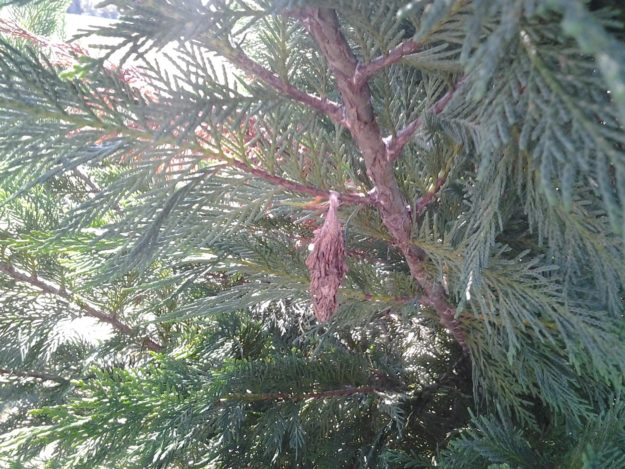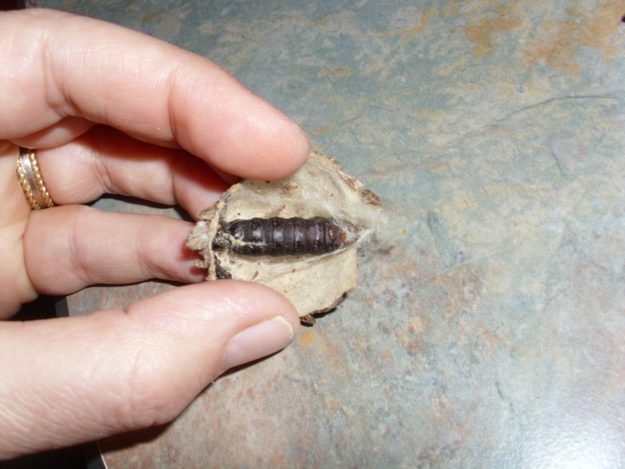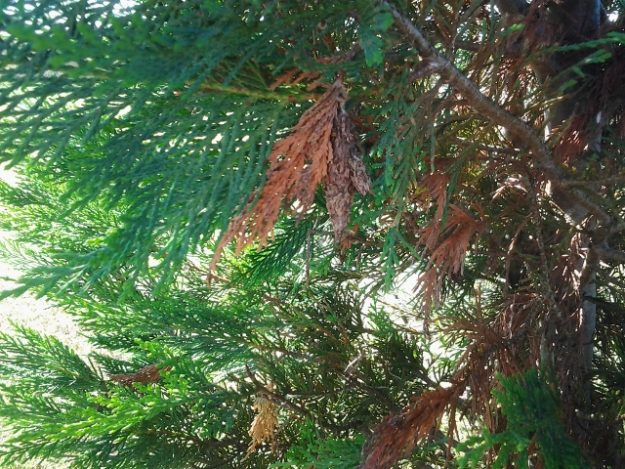
It has no eyes.
It has no legs.
It cannot eat.
Its sole purpose is to become a mummy for its offspring.
It is the Evergreen Bagworm.
So began Stephen’s first 4-H speech… Quite enthralling.
Have you ever seen one of these thingiemajiggers?

It’s not part of the tree. There’s a gross wormy thing in there!
‘Round about April-June, hundreds to thousands of itsy-bitsy caterpillars will hatch and crawl out of the mummified remains of their mom’s carcass and float away in the wind on a strand of silk. (Some sources say that mama moth drops out of the cocoon and dies. I think it’s more interesting to say it’s a mummy.) With that kind of knowledge, who wouldn’t want to cut a bagworm bag open? After all, we’ve never seen a mummified worm before!

Do you see the eggs? There are hundreds to thousands of them encased in that dark, wormy-looking thing. Do you see the silk? That’s a gift from mama moth, too.
So, these eggs will hatch, and the very hungry caterpillars will start to eat and eat and eat. They begin piecing together a sleeping bag made out of silk and material from the host plant. They drag their homemade sleeping bag everywhere they go. (To think, they make their own bed without having ever taken a course in Home Economics!)
In August, the larva wraps silk around a branch, so tightly that it actually damages the plant’s branches. After pupating, male evergreen moths emerge from the bag looking a bit like big flies or bees. The females? Well, they never grow antennae, nor wings, nor any of the things we mentioned previously. In Stephen’s words, “They just look like a big, fat grub.” For obvious reasons, she never leaves the cocoon. The female attracts a male to the cocoon, they mate through an opening in the cocoon, and then she dies with hundreds to thousands of eggs inside. And that’s where we are now. The eggs are overwintering as we pluck off these little bags hanging on the trees planted around a local church. Up to thousands of eggs are housed in each one. Wow.
Though fascinating creatures, these little moths are considered serious pests. They attack over a hundred species of trees, especially evergreens. And though the natural balance of the food chain usually keeps them in check in forests, they especially like to attack urban areas and evergreens used in landscaping. Their natural predators, woodpeckers and wasps, are just not as prevalent around our homes.
Plucking them off a tree does not fix the problem, either. The eggs will still hatch and crawl to the nearest host plant.

Stephen’s solution? Pluck them off and destroy them with FIRE or a great, big SLEDGEHAMMER.
Well, that might be a little much. But I think it’s a good reason to build a bonfire. Gig’em Aggies!
Other Nature Studies at Half-a-Hundred Acre Wood:
